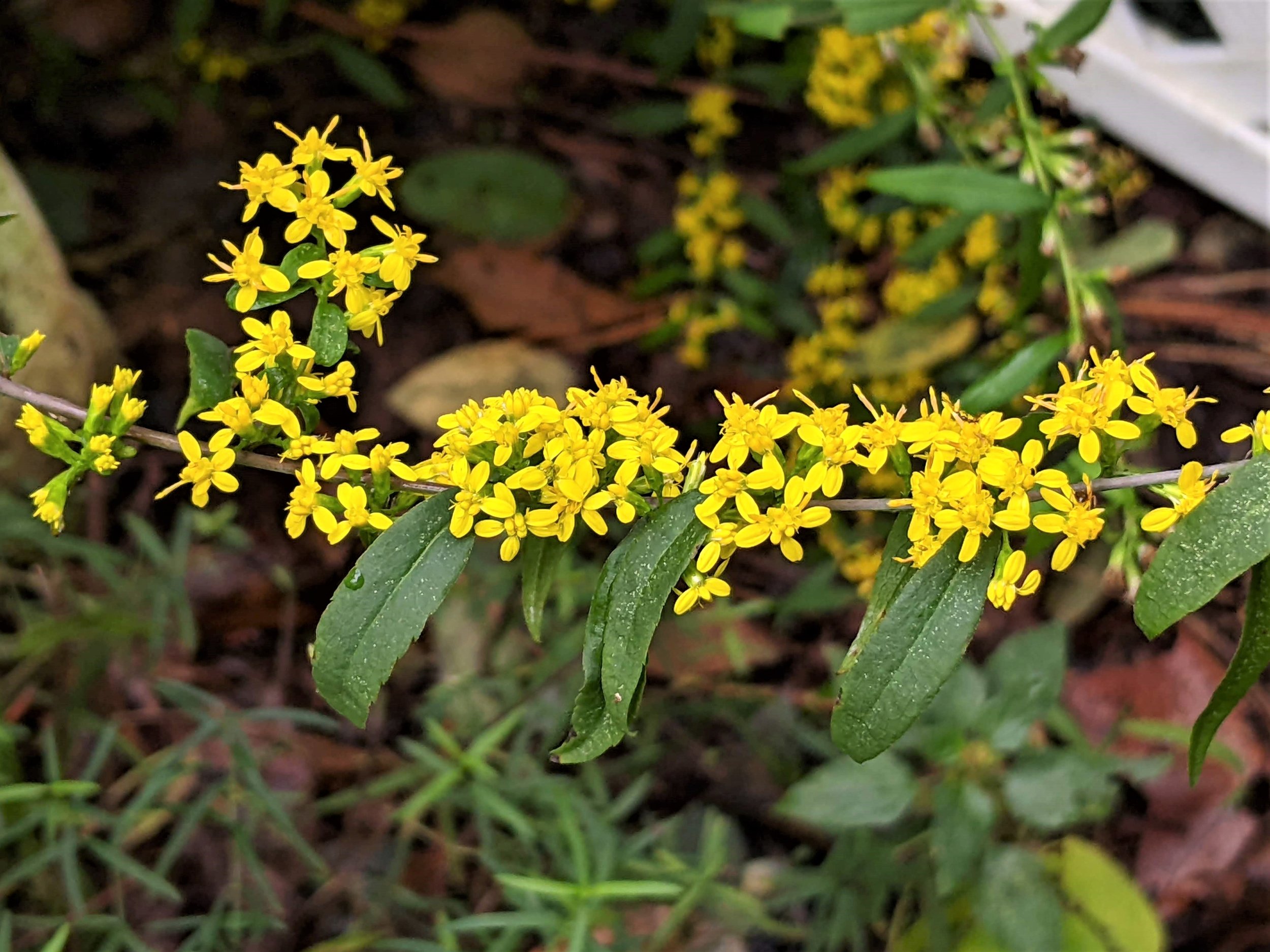Plant of the Month October 2022, Blue-stemmed Goldenrod
Blue-stemmed Goldenrod, Solidago caesia
Northern Neck Chapter of the Virginia Native Plant Society
October 2022, Plant of the Month
By Betsy Washington
At our recent fall plant sale a number of shoppers requested shade tolerant perennials that bloom in shady woodland gardens in late summer and fall, long after spring bloomers have faded. The October Plant of the Month, Blue-stemmed Goldenrod, Solidago caesia, fits the bill beautifully and like other Goldenrods, has the added benefit of supporting a large variety of pollinators and butterflies.
Lovely Blue-stemmed Goldenrod is blooming now in our woodlands and clearings. Yes indeed, a shade loving goldenrod with showy yellow blooms that provides high wildlife value even in shade! It grows naturally in dry upland and moist woodlands and openings throughout Eastern North America and occurs in nearly every county in Virginia. Sometimes called Woodland Goldenrod, this well-behaved goldenrod is the perfect plant to light up a woodland garden or path in fall as it does in nature
Blue-stemmed Goldenrod is aptly named with its smooth arching stems that tend to have a blue or purplish cast from a whitish waxy coating or ‘bloom’. Reaching only 2 to 3’ high, it features dark green slender lance-shaped leaves that alternate up the stems. From late August through October, loose clusters of small bright yellow flowers occur in the leaf axils (where each leaf meets the stem) along the entire stem in contrast to most goldenrods that feature feathery plumes at the top of the branches. Additionally, these clusters of tiny flowers completely encircle the stems creating a showy display and give rise to other common names, Axillary and Wreath Goldenrod. Like many members of the Aster Family, they have ray and disk (composite) flowers. If you look closely, each tiny yellow “flower” actually consists of two kinds of smaller flowers: 3 – 5 tiny ray florets encircle a central disc composed of tiny tubular florets creating a “composite” flower. These tiny flowers are rich in pollen and nectar and support an extremely diverse array of pollinators and bees. Goldenrods also provide critical late season nectar for migrating butterflies such as Monarchs, Painted Ladies, and Common Buckeyes. At least ten species of Fall specialist bees depend on the pollen from goldenrods to feed and raise their young, emerging only when goldenrods are in bloom. And readers that follow the eminent author and entomologist, Doug Tallamy, already know that Goldenrods host over 100 species of butterflies and moths, more than other herbaceous perennials. And if that is not enough wildlife value, goldenrod seeds are favored food of numerous migratory and grassland birds like goldfinches and other finches, juncos, indigo buntings and pine siskins, to name just a few. Despite their reputation for causing hay fever, goldenrods are pollinated by insects and have sticky pollen, not the windblown pollen that causes fall allergies. That nefarious honor goes to Ragweed (Ambrosia sp.), with its insignificant greenish yellow flowers that bloom at the same time.
Blue-stemmed Goldenrod is an adaptable plant and is easy to grow in gardens. It will tolerate full sun but prefers partial shade and is ideal when planted along woodland edges, paths, shady borders and openings. It is tolerant of a variety of soils from sandy to clay, and from moist to dry and is quite drought tolerant once established. It has no serious pests or diseases and is even somewhat resistant to deer. It is well behaved and will not spread aggressively but instead expand slowly into handsome 2 – 3’ wide clumps. This is the perfect perennial to alternate along a woodland path or border where the arching stems and showy clusters of yellow flowers will add welcome color in late summer and fall and attract a wealth of pollinators and songbirds – migrators and residents - to your garden. Consider combining it with the equally lovely fall blooming White Wood or Blue Wood Asters (Eurybia divaricatus and Symphyotrichum cordifolium) with frothy masses of white or blue flowers respectively, to further light up your woodlands and attract even more pollinators.
Photo Captions: (Photos by Denise Greene)
Photo 1. Showy flower clusters and leaves of Blue-stemmed Goldenrod
Photo 2. Blue-stemmed Goldenrod lights up a fall garden


